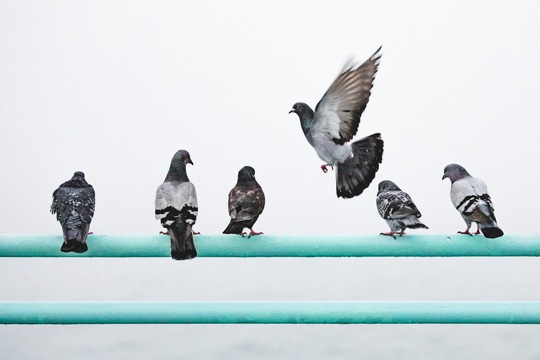
Focus first, then flee
Researchers from the Cluster of Excellence "Collective Behaviour" at the University of Konstanz have discovered when pigeons sharply recognize a predator and at what moment they take flight.
When observing pigeons, you quickly notice one thing: their heads are always in motion. Their heads are constantly nodding while walking, and tilting when the birds are looking at something. These movements are what researchers from the Cluster of Excellence "Collective Behaviour" at the University of Konstanz use to study the birds' lines of sight and their reactions to potential predators. How did the researchers go about?
They had to look deep into the eyes of the pigeons. On the retina, to be precise. There is a small depression where the area of sharpest vision is located, known as fovea. The human eye, too, has this area. The fovea enables us, for example, to read this line of text in razor-sharp focus, while the rest of the surroundings fade into the background.
Biologists have known where this point in the eye is for some time. An imaginary line extending from there defines the area of sharp vision. It is assumed that pigeons use their fovea to identify a threat. However, this assumption has not yet been scientifically investigated. During free group foraging, biologists Mathilde Delacoux and Fumihiro Kano from the Cluster of Excellence "Collective Behaviour" at the University of Konstanz have now used computer-assisted motion capture technologies to measure these gaze directions based on head posture and to analyze how pigeons behave when assessing predators.
As it turned out, pigeons use their fovea specifically to identify threats. "They focus on the source of the hazard in order to investigate it and assess the associated risk", explains Mathilde Delacoux. Pigeons that were busy eating were indeed slower to recognize the threat than conspecifics with their heads up. The researchers also found that the animals whose fovea focused on the danger took flight more quickly. A mere shadow in the peripheral field of vision, however, typically did not lead directly to a flight response. However, when they are pecking food in a group, the flight of several conspecifics in their peripheral field of vision is enough to trigger a flight response. Namely, the early detectors helped others to escape faster.
Thanks to the still new technology of 3D representation of head positions and gaze directions, both individual and group interactions can be analyzed and interpreted more precisely. "The results of the study are an important building block for research into what birds perceive, how they react to it individually and to what extent this influences the behaviour of the entire flock as a result", Fumihiro Kano summarizes the relevance of the study.
Key facts
- Original publication: Mathilde Delacoux, Fumihiro Kano (2024): Fine-scale tracking reveals visual field use for predator detection and escape in collective foraging of pigeon flocks: https://elifesciences.org/articles/95549
- Mathilde Delacoux is a doctoral researcher at the Cluster of Excellence "Collective Behaviour" at the University of Konstanz
- Dr Fumihiro Kanor is a group leader at the Cluster of Excellence "Collective Behaviour" at the University of Konstanz
- The Centre for the Advanced Study of Collective Behaviour at the University of Konstanz is a global hotspot for the study of collective behaviour across a wide range of species and across scales of organization.
